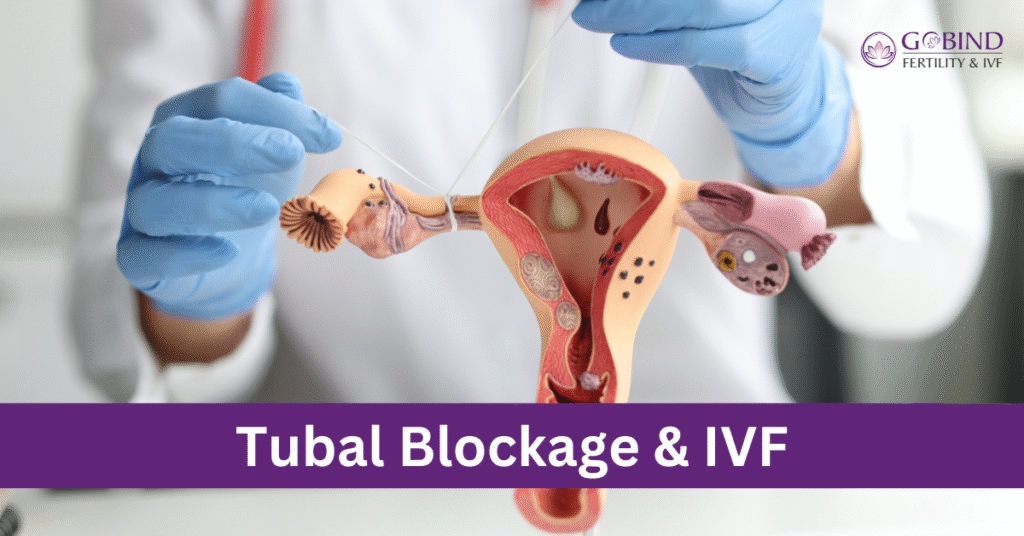Tubal Blockage and IVF: Is It Your Best Option?

For many women struggling with infertility, tubal blockage can be a major roadblock on their journey to conception. The fallopian tubes play a critical role in fertilisation by transporting the egg to the uterus. When these tubes are blocked or damaged, it becomes nearly impossible for the sperm to meet the egg naturally. This is where In Vitro Fertilisation (IVF) emerges as a powerful solution.
At Gobind Fertility & IVF Centre, we understand the emotional and physical challenges women face due to tubal infertility. In this article, we will explore the causes and symptoms of tubal blockage, how it’s diagnosed, and whether IVF is the best treatment option for women with blocked fallopian tubes.
What is Tubal Blockage?
Tubal blockage refers to an obstruction in one or both fallopian tubes, preventing the egg and sperm from meeting. This condition is one of the most common causes of female infertility and can result from various underlying issues.
Common Causes of Blocked Fallopian Tubes
- Pelvic Inflammatory Disease (PID)
- Endometriosis
- Past ectopic pregnancy
- Tubal ligation or surgery
- Uterine infections
- Sexually transmitted infections (STIs)
- Previous abdominal or pelvic surgeries
These conditions can cause scarring or adhesions in the fallopian tubes, resulting in partial or complete blockage.
Symptoms of Tubal Blockage
In many cases, tubal blockage shows no noticeable symptoms until a woman struggles to conceive. However, some signs may include:
- Chronic pelvic pain
- Painful periods or ovulation
- Pain during intercourse
- Unusual vaginal discharge
- History of PID or STIs
How is Tubal Blockage Diagnosed?
At Gobind Fertility & IVF Centre, we use advanced diagnostic tools to identify tubal blockage, such as:
- Hysterosalpingography (HSG): An X-ray test that checks the shape of the uterus and whether the fallopian tubes are open.
- Sonohysterography: An ultrasound-based procedure to detect abnormalities in the uterus and tubes.
- Laparoscopy: A minimally invasive surgery for direct visualisation and possible correction of tubal blockage.
Early and accurate diagnosis is key to determining the right fertility treatment.
Treatment Options for Tubal Blockage
Depending on the severity and location of the blockage, treatment may vary:
- Tuboplasty or Tubal Surgery: In some cases, surgery may restore the patency of the tubes. However, the success rates depend on factors such as age, extent of damage, and underlying causes.
- IVF (In Vitro Fertilisation): Considered the most effective treatment, especially when both tubes are completely blocked.
Why IVF is the Best Option for Tubal Blockage
When both fallopian tubes are blocked, IVF bypasses the tubes entirely, making it a highly successful option. Here’s why IVF at Gobind Fertility & IVF Centre is your best bet:
Bypasses Tubal Function
IVF eliminates the need for functional fallopian tubes since fertilization occurs outside the body in a lab.
Higher Success Rates
Our clinic reports high IVF success rates in patients with tubal infertility, particularly in younger women with good ovarian reserve.
Customised IVF Protocols
At Gobind Fertility & IVF Centre, we design personalized IVF protocols based on your hormonal profile, age, and medical history.
Advanced Fertility Technologies
We offer cutting-edge technologies like:
- Laser-assisted hatching
- Blastocyst culture
- Embryo freezing
- PGT (Preimplantation Genetic Testing)
These techniques enhance the chances of a healthy pregnancy.
What to Expect During IVF at Gobind Fertility & IVF Centre
- Initial Consultation: Includes a detailed medical history, hormone tests, and an ultrasound.
- Ovarian Stimulation: You’ll be given medications to stimulate the ovaries to produce multiple eggs.
- Egg Retrieval: A minor procedure under sedation to collect eggs.
- Fertilisation: Eggs are fertilised with the partner’s or donor’s sperm in the lab.
- Embryo Transfer: A selected embryo is placed in the uterus.
- Pregnancy Test: Performed two weeks later to confirm conception.
Our team provides compassionate care and support at every step.
Frequently Asked Questions (FAQs)
Q1. Can I conceive naturally if only one fallopian tube is blocked?
Yes, if the other tube is healthy and functional, natural conception may be possible.
Q2. How long does IVF take?
A typical IVF cycle lasts about 4-6 weeks from stimulation to embryo transfer.
Q3. Is IVF painful?
IVF is generally not painful. Egg retrieval is done under sedation, and most procedures are minimally invasive.
Q4. Is IVF safe for women with tubal blockage?
Absolutely. IVF is considered a safe and effective option for women with blocked fallopian tubes.
Q5. What is the cost of IVF treatment for tubal blockage?
The cost varies depending on your case. Gobind Fertility offers transparent pricing with flexible payment options.
Tubal blockage can be a frustrating and emotionally draining diagnosis, but it doesn’t mean the end of your fertility journey. IVF offers a reliable and effective pathway to parenthood, especially when traditional methods are not viable.
At Gobind Fertility & IVF Centre, we specialize in treating complex infertility issues, including tubal blockage. Our experienced fertility experts, world-class lab facilities, and compassionate approach make us one of the best IVF centres for tubal infertility treatment in India.
Contact Gobind Fertility & IVF Centre today to schedule your consultation and take the first step towards realizing your dream of parenthood.
